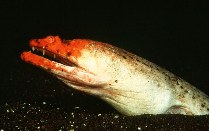| Family: |
Ophichthidae (Snake eels), subfamily: Ophichthinae |
| Max. size: |
120 cm TL (male/unsexed) |
| Environment: |
reef-associated; marine; depth range 0 - 30 m |
| Distribution: |
Indo-Pacific: East Africa in Tanzania, Seychelles and Mauritius (Ref. 3972), to the Society Islands (but not the Hawaiian Archipelago), north to Japan, south to Australia (Ref. 33390). |
| Diagnosis: |
Vertebrae: 116-124. Diagnosis: Dorsal fin arising well behind pectoral tips; pectoral fins teardrop-shaped; snout very short; jaws elongate; anterior nostril in a very short tube in upper lip, closely followed by an ethmoidal pore, a barbel, and the posterior nostril which is in outer lip and entirely covered by a flap; labial cirri numerous, unbranched and slender in anterior half of lip of mandible, those posterior and along lower lip branched at tips; flesh above and behind eye laterally elevated as a ridge; dorsal head profile notably incised and medially constricted behind eyes, the flesh forming a narrow transverse ridge behind dorsal margin of eyes; head pores and lateral-line pores apparent; free sensory neuromasts visible as rows of small white spots on nape; teeth conical (Ref. 42180). Lateral-line pores and temporal pores typically in dark spots; smaller dark spots present irregularly on flank between lateral line and dorsal fin of larger specimens (Ref. 42180). Eye small, coloured like the head, and placed towards the front of the long mouth (Ref. 48635).
Description: Characterized by head length 6.5-8.0 times in total length; body depth 16-25 times in total length; tail length equal to or less than body length (head and trunk) (Ref. 3972, 90102). Snout short, 13.0-19.0 in head length; eyes prominent and bulged; gape very large; numerous close-set cirri on side of jaws; upper jaw with two rows of fang-like teeth, the inner series larger; lower jaw with well-spaced canines; largest canines in single row on intermaxilla and vomer; lips fringed (Ref. 3972, 90102). Pectoral fin present; dorsal fin origin well behind head (Ref. 3972). Vertebrae 116-124 (Ref. 3972, 42180). Colouration: brownish, lighter below and on fins (Ref. 3972). |
| Biology: |
Generally found in shallow lagoon sand, rock and broken coral substrates at depths of 0-2 m (Ref. 42180). Benthic (Ref. 58302), occurs in sandy bottoms from intertidal to over 12 m.; remains buried in sand with only the eyes protruding where it waits to ambush fish (Ref. 9710) and octopuses (Ref. 275). Used in Chinese medicine (Ref. 12166). |
| IUCN Red List Status: |
Least Concern (LC); Date assessed: 19 November 2019 Ref. (130435)
|
| Threat to humans: |
harmless |
Source and more info: www.fishbase.org. For personal, classroom, and other internal use only. Not for publication.
